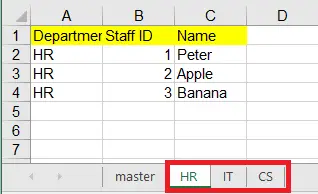This Excel VBA tutorial explains how to automate AutoFilter to filter value and then copy data to new worksheet or copy data to new workbook.
You may also want to read:
Excel VBA copy each worksheet to new workbook
Access VBA auto generate mass report by group to Excel
Filter value then copy filtered data to new worksheet
I find it very difficult to come up with a suitable title and key words for this post. I will try to describe what this Macro does with an example.
Suppose you have a staff list as below.
Now you want to create one worksheet for each department.
Worksheet “HR”
| Department | Staff ID | Name |
| HR | 1 | Peter |
| HR | 2 | Apple |
| HR | 3 | Banana |
Worksheet “IT”
| Department | Staff ID | Name |
| IT | 2 | John |
| IT | 6 | Judy |
Worksheet “CS”
| Department | Staff ID | Name |
| CS | 4 | Cat |
| CS | 5 | David |
If you have a hundred of unique department, it will take you forever to manually copy the data over to the new worksheet. What I want to achieve is to create a Macro to automatically filter each department and then copy the contents to a new worksheet.
VBA Code – Filter value then copy filtered data to new worksheet
To use this Macro:
1) Copy and paste the below code in a Module
2) Modify the 3rd row of code where the targetCol is the column that contains the department you want to break into separate worksheets
3) Select the worksheet that contains the staff list
4) Run the Macro
Public Sub FilterThenCopy() Dim ws, newWS, currentWS As Worksheet targetCol = 1 'define which column you want to break Dim objDict As Variant Set objDict = CreateObject("Scripting.Dictionary") Set currentWS = ActiveSheet 'Add unique value in targetCol to the dictionary Application.DisplayAlerts = False For r = 2 To Cells(Rows.Count, targetCol).End(xlUp).Row If Not objDict.exists(Cells(r, targetCol).Value) Then objDict.Add Cells(r, targetCol).Value, Cells(r, targetCol).Value End If Next r If currentWS.AutoFilterMode = True Then currentWS.UsedRange.AutoFilter End If currentWS.UsedRange.AutoFilter For Each k In objDict.Keys currentWS.UsedRange.AutoFilter field:=targetCol, Criteria1:=objDict.Item(k) 'delete worksheet if worksheet of item(k) exist For Each ws In ActiveWorkbook.Worksheets If wsExists(objDict.Item(k)) Then Sheets(objDict.Item(k)).Delete End If Next ws 'crate worksheet using item(k) name Set newWS = ThisWorkbook.Worksheets.Add(After:=Worksheets(Worksheets.Count)) newWS.Name = objDict.Item(k) 'copy filtered contents to new worksheet currentWS.UsedRange.SpecialCells(xlCellTypeVisible).Copy newWS.Range("A1").Select newWS.Paste Next k currentWS.Activate currentWS.AutoFilterMode = False Application.DisplayAlerts = True End Sub Function wsExists(wksName As String) As Boolean On Error Resume Next wsExists = CBool(Len(Worksheets(wksName).Name) > 0) On Error GoTo 0 End Function
Result
After you run the Macro, 3 new worksheets are created. The format should also be copied from the master staff list.
Filter value then copy to new workbook
Instead of copying data to new worksheet, you may want to copy to new workbook. Previously I wrote a post about copying each worksheet to new workbook, you just need to run the above Macro, and then run the copy to new workbook Macro. Click here to read my previous post.
Use Microsoft Access to generate mass report by Group
If you want to achieve the same result using Microsoft Access, click here to read my previous post. The advantage of using Microsoft Access is that you can use Query to transform data before export.


